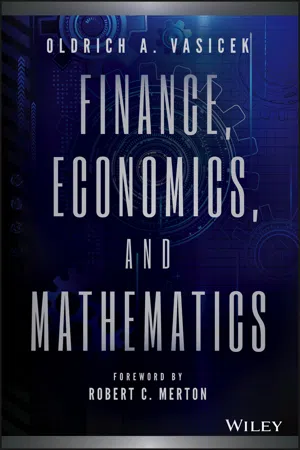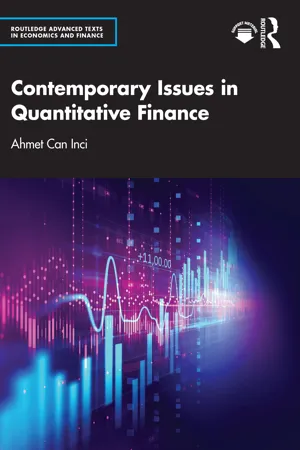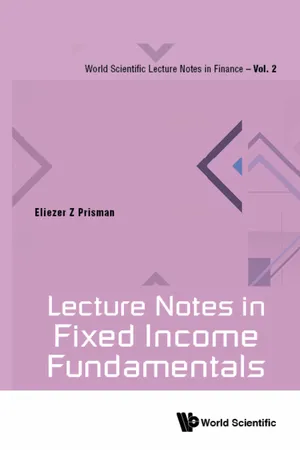Economics
Term Structure Application
Term structure application refers to the use of the term structure of interest rates to analyze and make decisions about financial markets and investments. It involves examining the relationship between the yields on different maturities of fixed-income securities. By understanding the term structure, investors and policymakers can gain insights into future economic conditions and make informed decisions about borrowing, lending, and investing.
Written by Perlego with AI-assistance
Related key terms
Related key terms
1 of 4
Related key terms
1 of 3
10 Key excerpts on "Term Structure Application"
- eBook - ePub
The Creators of Inside Money
A New Monetary Theory
- D. Gareth Thomas(Author)
- 2018(Publication Date)
- Palgrave Macmillan(Publisher)
The term structure of interest rates, however, recognises a common link between them all in the form of expectations of the future, whether long or short, which determines the holding of various financial assets of maturity as well as influencing the determination of aggregate demand and supply within the real economy. The term structure, therefore, is important for Central Bank ’s policymakers. If these monetary instruments affect short-term rates of interest in the first instance, which leads to the determination of long-term rates of interest, which drives capital and consumption expenditure, then analysing the term structure is crucial for understanding the transmission mechanism of monetary policy (Fender 2012). 1 Nevertheless, it is also relevant for many households in terms of the portfolio choice of assets. Suppose a family requires expenditure on private school fees in ten years’ time and decides to save now. There are a number of options. They could save by investing into a ten-year bond. Alternatively, they could purchase a short-term bill and then take the earnings into another bond each time it matures, until the ten years are up. Clearly, the important components determining the choice will be the expected return (or cost) and the risk involved, embodied in the term structure. Therefore, the analysis must consider the various theoretical models put forward in the literature to explain the relationship between interest rates on bonds (or bills) of differing maturity, although the hypothesis can applied to other assets as diverse as housing and the mortgage rate. The foremost theory of the term structure of interest rates is the so-called expectations hypothesis, which focuses on the rôle of expectations of future short-term interest rates in the determination of prices and yields on longer-term bills (or bonds). There a number of ways in which the theory in the literature differs in terms of the length of the bills (or bonds) included in the analysis - eBook - ePub
- Oldrich A. Vasicek(Author)
- 2015(Publication Date)
- Wiley(Publisher)
Term structure of interest rates provides a characterization of interest rates as a function of maturity. It facilitates the analysis of rates and yields such as discussed in Dobson, Sutch, and Vanderford [1976], and provides the basis for investigation of portfolio returns as for example in Fisher and Weil [1971]. Term structure can be used in pricing of fixed-income securities (cf., for instance, Houglet [1980]), and for valuation of futures contracts and contingent claims, as in Brennan and Schwartz [1977]. It finds applications in analysis of the effect of taxation on bond yields (cf. McCulloch [1975a] and Schaefer 1981), estimation of liquidity premia (cf. McCulloch [1975b]), and assessment of the accuracy of market-implicit forecasts (Fama [1976]). Because of its numerous uses, estimation of the term structure has received considerable attention from researchers and practitioners alike.A number of theoretical equilibrium models has been proposed in the recent past to describe the term structure of interest rates, such as Vasicek [1977] (Chapter 6 of this volume), Brennan and Schwartz [1979], Langetieg [1980], and Cox, Ingersoll, and Ross [1981]. These models postulate alternative assumptions about the nature of the stochastic process driving interest rates, and deduct a characterization of the term structure implied by these assumptions in an efficiently operating market. The resulting spot rate curves have a specific functional form dependent only on a few parameters.Unfortunately, the spot rate curves derived by these models (at least in the instances when it was possible to obtain explicit formulas) do not conform well to the observed data on bond yields and prices. Typically, actual yield curves exhibit more varied shapes than those justified by the equilibrium models. It is undoubtedly a question of time until a sufficiently rich theoretical model is proposed that provides a good fit to the data. For the time being, however, empirical fitting of the term structure is very much an unrelated task to investigations of equilibrium bond markets. - eBook - ePub
- Frank J. Fabozzi, Frank J. Fabozzi(Authors)
- 2012(Publication Date)
- Wiley(Publisher)
The Dynamic Term Structure Model DAVID AUDLEY, PhD Senior Lecturer, The Johns Hopkins University RICHARD CHIN Investment Manager, New York Life Investments PETER C. L. LIN PhD Candidate, The Johns Hopkins University SHRIKANT RAMAMURTHY Consultant, New York, NY Abstract: The term structure of interest rates represents the cost of (return from) borrowing (lending/investing) for different terms at any one moment in time. The term structure is most often specified for a specific market such as the U.S. Treasury market, the bond market for double A rate financial institutions, the interest rate market for LIBOR and swaps, and so on. The term structure is usually specified via a rate or yield for a given term or the discount to a cash payment at some time in the future. These are often summarized mathematically through a wide variety of models. In addition, term structure models are fundamental to expressing value, risk, and establishing relative value across the spectrum of instruments found in the various interest-rate or bond markets. Dynamic models of the term structure are characterizations that are specifically established to consider future market scenarios where there is uncertainty. As such they are rooted in probability, stochastic process, and martingale theory. Standard models include those derived from assumptions that include a short-rate or a forward rate process as an explanatory factor for the evolution of markets. Instantiations of these models include a general zero-coupon bond pricing equation 2nd the LIBOR market model. An important consideration includes expressing the market price of risk that allows for the complexity of the term structure of interest rates to exist without arbitrage, as found from the traded markets - eBook - ePub
- Frank J. Fabozzi, Frank J. Fabozzi(Authors)
- 2012(Publication Date)
- Wiley(Publisher)
A,. and Fong, H. G. (1982). Term structure modeling exponential spline. Journal of Finance (May): 339–348. The Dynamic Term Structure Model DAVID AUDLEY, PhD Senior Lecturer, The Johns Hopkins University RICHARD CHIN Investment Manager, New York Life Investments PETER C. L. LIN PhD Candidate, The Johns Hopkins University SHRIKANT RAMAMURTHY Consultant, New York, NY Abstract: The term structure of interest rates represents the cost of (return from) borrowing (lending/investing) for different terms at any one moment in time. The term structure is most often specified for a specific market such as the U.S. Treasury market, the bond market for double A rate financial institutions, the interest rate market for LIBOR and swaps, and so on. The term structure is usually specified via a rate or yield for a given term or the discount to a cash payment at some time in the future. These are often summarized mathematically through a wide variety of models. In addition, term structure models are fundamental to expressing value, risk, and establishing relative value across the spectrum of instruments found in the various interest-rate or bond markets. Dynamic models of the term structure are characterizations that are specifically established to consider future market scenarios where there is uncertainty. As such they are rooted in probability, stochastic process, and martingale theory. Standard models include those derived from assumptions that include a short-rate or a forward rate process as an explanatory factor for the evolution of markets. Instantiations of these models include a general zero-coupon bond pricing equation 2nd the LIBOR market model. An important consideration includes expressing the market price of risk that allows for the complexity of the term structure of interest rates to exist without arbitrage, as found from the traded markets - (Author)
- 2019(Publication Date)
- Wiley(Publisher)
B is correct. The existence of a liquidity premium ensures that the forward rate is an upwardly biased estimate of the future spot rate. Market evidence clearly shows that liquidity premiums exist, and this evidence effectively refutes the predictions of the unbiased expectations theory.Solution to 5:
A is correct. Although the local expectations theory predicts that the short-run return for all bonds will be equal to the risk-free rate, most of the evidence refutes that claim. Returns from long-dated bonds are generally higher than those from short-dated bonds, even over relatively short investment horizons. This market evidence is consistent with the risk–expected return trade-off that is central to finance and the uncertainty surrounding future spot rates.5 . Modern Term Structure Models
Modern term structure models provide quantitatively precise descriptions of how interest rates evolve. A model provides a sometimes simplified description of a real-world phenomenon on the basis of a set of assumptions; models are often used to solve particular problems. These assumptions cannot be completely accurate in depicting the real world, but instead, the assumptions are made to explain real-world phenomena sufficiently well to solve the problem at hand.Interest rate models attempt to capture the statistical properties of interest rate movements. The detailed description of these models depends on mathematical and statistical knowledge well outside the scope of the investment generalist’s technical preparation. Yet, these models are very important in the valuation of complex fixed-income instruments and bond derivatives. Thus, we provide a broad overview of these models in this reading. Equations for the models and worked examples are given for readers who are interested.5.1 . Equilibrium Term Structure Models
Equilibrium term structure models are models that seek to describe the dynamics of the term structure using fundamental economic variables that are assumed to affect interest rates. In the modeling process, restrictions are imposed that allow for the derivation of equilibrium prices for bonds and interest rate options. These models require the specification of a drift term (explained later) and the assumption of a functional form for interest rate volatility. The best-known equilibrium models are the Cox–Ingersoll–Ross model 10 and the Vasicek model ,11- eBook - ePub
- Friedrich A. Lutz(Author)
- 2017(Publication Date)
- Routledge(Publisher)
If a lender knows exactly how long his money will be available for investment, he can select the maturity date of the claim in such a way that he runs neither an income risk nor a capital risk. If he chooses a maturity date earlier than the point in time at which he needs cash, he will not run the risk of a capital loss since he can always invest his money a second time for the “correct” date, but he runs an income risk since the rate of interest obtainable on the second investment may be lower. If, on the other hand, he selects a maturity date later than the date on which he needs his money, his income from the investment will be certain, but not the capital value. Only the coincidence of the maturity date of the claim and the date of his need for cash will insure him simultaneously against both types of risk – that is, insure him against what we shall call yield risk (yield = interest plus capital gain or minus capital loss).If we assumed the relevant dates to be known and all participants in the market to be intent exclusively on avoiding any risk, the capital market would consist of a great number of tightly sealed compartments, one for each maturity date, in which the supply of and demand for bonds of each given maturity would determine the interest rate on these bonds irrespective of what happened in the other compartments. The term structure of interest rates would then be determined exclusively by the maturity structure in which debtors wanted to borrow money on the one hand, and on the other hand by the maturity structure in which owners of funds wanted to invest their money. If on the demand side the demand for long-term capital were to predominate and on the supply side the offer of short-term money, the long rates would come to lie above the short rates, and vice versa in the opposite case. Under the “expectation theory”, by contrast, the maturity structure of claims or debts has no influence at all on the term structure of interest rates as long as perfect foresight or at least the absence of risk aversion is assumed.It was Culbertson who more than anybody else stressed the maturity structure of debts as an important – although not the only – factor determining the term structure of interest rates.5 On this theory the rate structure can be influenced to a significant degree by the debt management policies of the government, as for instance when it shifts from short-term into long-term debt or vice versa. Changes in the economic structure also influence the structure of interest rates, since the length of time for which debts are incurred changes with the purpose for which borrowing is effected. Accordingly, Culbertson points out that “shifts in business and financial developments tend to be reflected in changes in the maturity structure of borrowing. Business inventory developments and securities speculation are reflected in changes in short-term borrowing; changes in automobile sales affect extensions of the intermediate-term credit commonly used in this area; changes in sales of new houses, in business fixed investment, in state and local government construction are reflected in demands for new long-term credit”.6 - eBook - ePub
- Ruediger Bachmann, Giorgio Topa, Wilbert van der Klaauw(Authors)
- 2022(Publication Date)
- Academic Press(Publisher)
9 All three estimates share a similar broad pattern – a fairly stable natural rate around 2% up until the financial crisis followed by a marked decline.17.3 Expectations and the term structure of interest rates
Monetary policy affects the aggregate economy primarily via the term structure of interest rates. While central banks have tight control over short-term rates, the efficacy of monetary policy depends on the ability to affect longer-maturity interest rates which drive the saving and investment decisions of households and firms. Standard macroeconomic models assume that the transmission mechanism of monetary policy is given by the expectations hypothesis: yields on longer-term government bonds reflect the average short rate that investors expect to prevail over the life of the bond.We now use the fitted term structure of expectations to evaluate how well movements in future short rate expectations explain long-term yields. We do this by decomposing observed government bond yields into an expectations hypothesis component and a residual component which we interpret as a measure of the subjective term premium perceived by professional forecasters. Because our survey-based term premiums represent the residual between yields and expected short rates, we can remain agnostic about what specifically they represent. For example, they might reflect shifts in investor risk attitudes leading to time variation in expected excess bond returns, differences between the expectations of the marginal investor and consensus expectations, or frictions in the bond market which prevent the elimination of arbitrage opportunities. Hereafter we will refer to this measure as the “term premium” for simplicity.17.3.1 Decomposing the term structure of interest rates
We obtain zero coupon U.S. Treasury yields from the Gurkaynak et al. (2007) dataset available on the Board of Governors of the Federal Reserve's research data page.10 The sample period is March 1983–December 2019. Letbe the continuously compounded yield on an n-month discount bond andy t( n )i tthe risk-free nominal short rate at time t. To separate longer-term from short-term expectations, we conduct our analyses in terms of forward rates, defined as the current yield of an n-month bond maturing inn + m - eBook - ePub
- Ahmet Can Inci(Author)
- 2023(Publication Date)
- Routledge(Publisher)
There are many more stochastic models for interest rate dynamics. However, the ones explored here are the most popular and most useful models. The stochastic equations covered earlier can be used to drive the expressions for bond prices using equation 11.11. Most of the models presented here are one-factor models. One random variable, and therefore, one economic variable – the short-term interest rate – is the driver of all the interest rates. The single factor is present as a linear factor in all the stochastic equations. As a consequence, the models in equations 11.12 through 11.17 are known also as affine models of interest rates with respect to the random factor.11.7 TERM STRUCTURE OF INTEREST RATES
The term structure of interest rates, or the yield curve, is a graph of the yields of bonds plotted against their maturities. The bonds have as little frictional risk as possible; by focusing on government bonds, liquidity risks and bankruptcy risks are avoided. The yield curve using only government bonds is typically upward-sloping, as in Figure 11.2 , considered indicative and predictive of a healthy economy. On the other hand, an inverted (downward-sloping) yield curve predicts a recession. Humped-shaped or flat-term structures are also possible from time to time.The Typical Term Structure of Interest Rates in a Normal EconomyFIGURE11.2Researchers are interested in the shape of the term structure of interest rates from two perspectives: (1) Why is there a certain shape of the term structure? (2) How can the shape of the term structure be predicted so that this predictive power of the term structure over the economy and financial markets helps make advanced and better investment rebalancing decisions?To address the first perspective, why the shape of the term structure, researchers have proposed and tested several term structure theories:-
Pure expectations theory: This theory suggests that short-term rates can be used in conjunction with forward rates to predict longer-term interest rates. For example, the two-year bond yield can be determined from the one-year bond yield and the forward rate of a 1-year bond which will be active during the following year:
- Maureen Burton, Reynold F. Nesiba, Bruce Brown(Authors)
- 2015(Publication Date)
- Routledge(Publisher)
We are interested in explaining what determines the term structure—that is, the shape of the yield curve and its level. Although much has been written to explain the term structure of interest rates, the conventional wisdom can be boiled down to expectations theory and some modifications of that theory. To simplify the explanation of the theory and the modifications, we shall assume that there are only two types of Treasury securities: T-bills with a short term to maturity (one year) and Treasury notes with a long term to maturity (two years). We shall develop our analysis in terms of the demand for and supply of these two securities. In Chapter 5, we discussed interest rate determination in terms of the supply of and demand for loanable funds. By now you should be able to see that when we supply loanable funds, we demand financial securities, and when we demand loanable funds, we supply financial securities. Thus, developing our analysis of the expectations theory in terms of the demand for and supply of financial securities is consistent with our previous discussion. Recap The yield curve is a graphical representation of the relationship between the interest rate (yield) and the term to maturity. Yield curves show how interest rates vary with term to maturity. The Expectations Theory Simply put, the expectations theory postulates that (1) the yield curve is determined by borrowers’ and lenders’ expectations of future interest rates and (2) changes in the slope (shape) of the curve result from changes in these expectations- eBook - ePub
- Eliezer Z Prisman(Author)
- 2017(Publication Date)
- WSPC(Publisher)
Chapter 3
The Term Structure, its Estimation, and Smoothing
In the last chapter we investigated the meaning of the discount factors and their relation to the NA condition, and valuing future cash flows utilizing the present value concept. Some financial instruments, that also fall into the class of derivative securities, are valued based on risk-free discount factors. The valuation concept of these instruments is induced by the no-arbitrage condition. These securities are valued either by replication or by applying to their cash flow the discount factors.The risk-free discount factors are implicit in bond prices, as we saw in Chapter 2 . They are consequences of the no-arbitrage condition. However before we dwell on the valuation issue, we introduce the reader to some estimation matters, terminology such as yield, yield curve, spot curve, and zero-coupon curve, and their interrelation.3.1 The Term Structure of Interest Rates
The discount factors (ds) reflect the discounting due to the time value of money. Thus, they have implicit in them the interest rate that prevails in the market. For example, if d1 = 0.9 it means that in this market a dollar at time one is worth 0.9 of a dollar today. The difference in value between a dollar today and a dollar received in the future results from the opportunity cost of investing that dollar at the risk-free rate of interest. A dollar today can be invested in a risk-free asset from time zero to time one and will earn a rate of interest which we denote by r1 . Hence a dollar today will be equal to 1 + r1 dollars at time one. Consequently, if invested at the risk-free rate from time zero to time one, will grow to be one dollar. It thus follows thatand we can solve for r1 in terms of d1 .> solve(d1=1/(1+r1),r1);The rate r1 is called the spot rate spanning the time interval zero to one. It is the rate applied to loans which commence now (at time zero) and which mature at some time in the future — time one in this example. In the same manner we can calculate the rate r2
Index pages curate the most relevant extracts from our library of academic textbooks. They’ve been created using an in-house natural language model (NLM), each adding context and meaning to key research topics.
Explore more topic indexes
Explore more topic indexes
1 of 6
Explore more topic indexes
1 of 4









